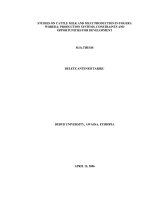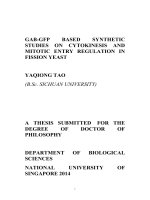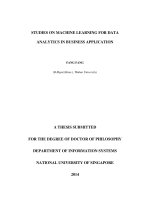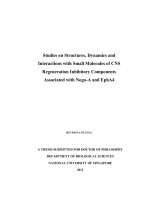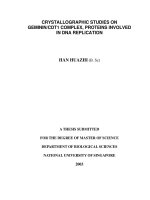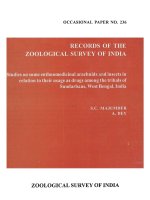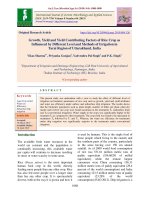Soil test crop response studies on cowpea (Vigna unguiculata (L). Walp.) in Mollisol of Uttarakhand, India
Bạn đang xem bản rút gọn của tài liệu. Xem và tải ngay bản đầy đủ của tài liệu tại đây (247.79 KB, 9 trang )
Int.J.Curr.Microbiol.App.Sci (2019) 8(5): 1533-1541
International Journal of Current Microbiology and Applied Sciences
ISSN: 2319-7706 Volume 8 Number 05 (2019)
Journal homepage:
Original Research Article
/>
Soil Test Crop Response studies on Cowpea (Vigna unguiculata (L). Walp.)
in Mollisol of Uttarakhand, India
Varun Tripathi*, Sobran Singh1 and Bal Mukund Pandey2
1
Department of Soil Science, College of Agriculture, G.B. Pant University of Agriculture and
Technology, Pantnagar, Uttarakhand, 263145, India
2
Department of Agriculture, T. D. P.G. College Jaunpur, U.P. India
*Corresponding author
ABSTRACT
Keywords
Mollisol, Fertilizer
recommendation,
Cowpea, Yield
target and nutrient
requirement
Article Info
Accepted:
15 April 2019
Available Online:
10 May 2019
A field experiment was conducted during spring 2009-2010 in a Aquic hapludoll at the
Norman E. Borlaug Crop Research Centre of the G.B. Pant University of Agriculture and
Technology, Pantnagar (290 N latitude and 79 0 29’ E longitude), as per technical
programme of All India Coordinated Research Project on the soil test crop response
correlation. The experiment was conducted in “two-phases”. In the first phase soil fertility
gradient was developed by dividing the experimental field into “three strips” and applying
graded doses of fertilizers in them (Strip I no fertilizer), Strip II (100, 100 and 100 kg/ha
N, P2O5 and K2O/ha) respectively, and strip III (200, 200 and 200 kg N, P 2O5 and K2O)
respectively and growing of exhaust crop Oat (Var. Kent). In the second phase, i.e. next
season test crop Cowpea (var. Pant lobia-1) was grown by dividing each strip into twentyfour plots having twenty-three fertilizer treatments and one control plot. Response to
“select” combinations of “three-levels” of FYM (0, 5 and 10 t/ha), “four-levels” of
nitrogen (0, 15, 30 and 45 kg/ha), four levels of phosphorus (0, 30, 60 and 90 kg/ha) and
four levels of potassium (0, 30, 60 and 90 kg/ha) at different fertility levels of cowpea was
studied. The values of the organic carbon, Alkaline KMnO 4 extractable N, Olsen’s P and
neutral normal Ammonium Acetate extractable K in the experimental field ranged between
0.72-1.16 per cent, 112.30-200.60 kg/ha, 13.00-24.24 kg/ha and 101.90-245.30 kg/ha,
respectively. In the present investigation the total straw yield ranged from 13.07-24.94
q/ha and total grain yield ranged from 9.00-18.20 q/ha. The nutrient requirement for
production of one quintal of cowpea grain was found to be 5.71 kg of nitrogen, 0.90 kg of
phosphorus and 3.72 kg of potassium. Per cent contribution of nitrogen, phosphorus and
potassium was 62.00, 59.00 and 32.00 from soil, whereas from other sources as FYM was
7.00, 29.00, 10.00; chemical fertilizer 30.00, 14.00 and 30.00 and conjoint use of chemical
fertilizer with FYM 30.00, 17.00 and 27.00 in terms of NPK respectively. With the help of
these data fertilizer recommendation at different yield targets and soil test value can be
calculated. Coefficient of quadratic multiple regression (R 2) was found highly significant
(0.898**) between grain yield, soil test values, added fertilizers and FYM. Organic carbon,
alkaline KMnO4-N, Olsen’s-P and AB DTPA and Ammonium acetate K and AB DTPA K
methods of available N, P and K respectively were at par for the cowpea grown in Mollisol
of Uttarakhand.
1533
Int.J.Curr.Microbiol.App.Sci (2019) 8(5): 1533-1541
Introduction
Cowpea (Vigna ungiculata (L.) Walp), an
annual legume, also commonly referred to as
southern pea, black eyed pea, crowder pea,
lobia, niebe coupe or frijole. It is one of the
ancient crops to man. The history of cowpea
dates to ancient West African cereal farming,
5 to 6 thousand years ago, where it was
closely associated with the cultivation of
sorghum and pearl millet. It is also grown in
Latin America, and southern United States.
The black- eyed cowpea type is grown up
primarily in California and marketed as
California black-eyed pea. Worldwide
production of cowpea has increased
dramatically in the last 25 years. It is a warmseason crop well adapted to many areas of the
humid tropics and temperate zones. It
tolerates heat and dry conditions but is
intolerant of frost. This crop has a
considerable promise as an alternative pulse
crop in dry land farming. Cowpea performs
best on well-drained sandy loam or sandy
soils where soil pH is in the range of 5.5 to
6.5. Being a leguminous crop, it requires soil
application of NPK as a starter dose for better
initial establishment. In an estimate, 3.3
million tons of cowpea dry grains were
produced worldwide during the year 2000.
The world average yield was 337 kg/ha
(Bressani et al., 1985); IITA, (2000). Within
India; cowpea is grown in an area of 3.9
million hectares with a production of 2.21
million tones and productivity of 567 kg/ha.
Pulses are the important sources of proteins,
vitamins and minerals for the predominantly
vegetarian population and are popularly
known as “poor man’s meat” and “rich man’s
vegetable” (Singh et al., 1992). Importance of
fertilizer to increase food grain production is
well recognized. Agricultural production is
intensifying by the sharp increase in fertilizer
consumption, but productivity gains of added
nutrients are declining. Nutrient supply from
chemical fertilizers is the key to increase the
agricultural production. Enhanced land
productivity results from the synergistic
effects of chemical fertilizers, organic
manures, biofertilizers and other locally
available nutrient sources, which improve soil
organic carbon, and nutrient status
consequently
chemical,
physical
and
biological properties of soil. Since plants
derive nutrients from both soil and fertilizers,
it is necessary to minimize the wastage of
fertilizer status in the soil to ensure their
economic and judicial use. The need of to use
renewable forms of energy have revived the
use of organic fertilizers worldwide. Nutrients
contained in organic manures are released
more slowly and are stored for a longer time
in the soil, thereby ensuring a long residual
effect (Sharma et al., 1991). Improvement of
environmental conditions and public health as
well as the need to reduce the cost of
fertilizing crops are also important reasons for
advocating increased use of organic materials
(Seifritz, 1982). Application of organic
manures also improves the soil microbial
properties Belay et al., (2001). The benefits
derivable from the uses of organic materials
have however not been fully utilized in the
humid tropics due to huge quantities required
to satisfy the nutritional needs of crops as
well as transportation and handling costs
which constitute major constraints. They are
rarely available to the small-scale farmers in
the required large quantities (Nyathi et al.,
1995).
During the post green revolution period, the
production of pulses recorded a negative
growth rate. This disturbing trend in the
production of pulses had adversely affected
the per capita availability of pulses. Soil
testing is one of the important tools to
accesses the fertility status of soil and provide
the basis of nutrient requirement for a
crops/cropping sequence. This helps to
economize the cost of fertilizer use and will
increase the fertilizer use efficiency. Soil
1534
Int.J.Curr.Microbiol.App.Sci (2019) 8(5): 1533-1541
testing also aids in monitoring of soil health
and environment over time. In the current and
future scenario, soil testing must be renamed
as soil quality assessment and it must assume
a holistic role not limited to guide fertilizer
recommendation for a crop based on soil test
Goswami (2006). Hence the soil testing has
become the foundation for fertilizing our soils
in balanced proportion and to understand
nutrient losses from the soil. The soil test
values should be correlated and calibrated for
recommending the fertilizer requirement of a
crop on a specific soil climate zone. In the
absence of such information, no precise
fertilizer recommendations would be possible.
Keeping these factors in view, an All India
coordinated research Project on Soil Test
Crop Response Correlations was started by
the Indian Council of Agricultural Research
in the 1967-1968.Various aspects of the
problem and approaches for solution were
calculated and debated at the national level.
Finally detailed technical programme tried up
to guide laboratory and field experimentation.
In the field experimentation under this
programme, the yield variations due to
management practices and the soil factors
other than the nutrient under study were
avoided by creating the desired fertility
variations artificially on the same field at few
selected sites representing various soil and
agro-climatic zones of the country. The
concept of formulating optimum fertilizer
recommendation for targeted yield was first
given by Troug (1960) which further
modified by Ramamoorthy et al., (1967).
The relationship between yield of economic
part and uptake of a nutrient will usually be
linear. This implies that for obtaining a given
yield, a definite quantity of the nutrient must
be in use by the plant. Once this requirement
is recognized for a given yield, a definite
quantity of the nutrient must be in use by the
plant. Once this requirement is recognized for
a given yield, the fertilizer need can be
estimated by taking account of efficiency or
contribution from the nutrient available in soil
and from the fertilizer applied. The data
obtained from the Soil Test Crop Response
field experiment provides a range in soil test
values, nutrient uptake and yield levels, which
enables us in calculating the three basic
parameters i.e. nutrient requirements, percent
contribution from the applied nutrient through
inorganic or organic sources. Today, we are
overwhelmed to hear that Soil Test Crop
Response (STCR) based prescription are
gaining popularity due to their superiority
over
blanket
general
fertilizer
recommendations. Field trials conducted in
different agro-ecological zones with different
cropping systems revealed that the STCR
produced higher yields and maintains better
nutrient status as compared to blanket
fertilizers recommendation. This approach of
efficient fertilizer management increases the
production potential for yield of pulses.
Materials and Methods
Field experiment was conducted in B3 block
of Norman E. Borlaug Crop Research Centre
(C.R.C), of G.B. Pant University of
Agriculture and Technology, Pantnagar, Distt.
U S. Nagar, Uttarakhand on Soil Test Crop
Response Studies as per the technical
programme of A.I.C.R.P. During spring 201011. The Crop Research Centre is situated at
the foot hills of Shivalik range of Himalayas
at 290 N latitude, 790 29’ E longitude and an
altitude of 243.84 m above the mean sea
level. Climate of Pantnagar is humid,
subtropical with hot and dry summers and
cool winters. The monsoon season usually
starts from third or fourth week of June and
extends up to last week of September. Few
spells of downpours are generally received
during winter season (November to
march).The average annual rainfall of the area
is 1433.3 mm and approx. 80-90 percent of it
is received during rainy season. Soils of this
1535
Int.J.Curr.Microbiol.App.Sci (2019) 8(5): 1533-1541
region are developed from medium to
moderately coarse textured calcareous
alluvium brought down from mountains by
numerous streams flowing through Bhabhar
and Tarai. These are mainly silty and loamy in
texture with weak fine to medium fine
granular structure, having good moisture
storage capacity and these are considered as a
highly productive soil.
Composite soil samples were processed and
analysed for various physicochemical
properties (Table 1).
In the beginning fertility gradient across the
width of field was created by adding different
doses of N, P and K fertilizers and growing
Oat var.-Kent as exhaust crop, during Rabi
2010. This is for successful soil test crop
response correlation study and to minimize
the interference of other soil and management
factors affecting crop yield response.
In the beginning first phase, 2010 land was
prepared in the month of September. For
preparation of field one disc ploughing
followed by two cross harrowing was done.
The field was levelled with the help of tractor
drawn leveler to give gentle slope for smooth
drainage on the same day. Experimental site
was divided into three equal strips and applied
three levels of nutrients, viz 0, 1 and 2 (i.e.)
N0P0K0, N1P1K1 and N2P2K2 as given in table
2.
Nitrogen, phosphorus and potash were
applied as urea, single super phosphate and
muriate of potash, respectively. Half dose of
nitrogen and full dose of phosphorus and
potash were applied by placement method.
The remaining half dose of nitrogen was
applied 45 DAS. Line sowing was done at 23
cm row to row distance and plant to plant to
plant distance 5 cm. Seeds of variety Kent
were sown at the rate of 100 kg/ha. For
raising the crop recommended agronomic
practices were adopted. This crop was
harvested at 50 % flowering (Table 3).
During second phase a test crop, Cowpea var.
Pant lobia-1 was sown on the site of fertility
gradient experiment. Land was prepared with
one disc ploughing followed by four cross
harrowing. The field was leveled without
disturbing strip boundaries with the help of
leveler to furnish gentle slope for better
drainage Each strip was divided into 24 plot
(23 treated and one control plot) resulting in
total seventy two (24×3) plots (3m × 3m size)
plots. These treatments comprised of various
selected
combinations
of
nitrogen,
phosphorus, potassium and farmyard manure
were randomized in each of the three strips.
Nitrogen, phosphorus, potassium and organic
manure were applied through urea, single
super phosphate muriate of potash and FYM,
respectively. Half of nitrogen, total
phosphorus, total potash and total dose of
FYM were broadcasted as basal and mix well
in soil with spade before sowing. While
remaining half of nitrogen was applied 30
DAS. An attempt was made to keep the crop
free of weeds, insects, pests and diseases
following the recommended agronomic
practices.
Soil samples were collected plough layer (015 cm depth) from each plot of strips I, II and
III before addition of any manure or fertilizer.
Plant samples were collected from each plot
at the time of harvest (physiological maturity
stage) and were dried to constant weight at
700 C.
After threshing of the harvested produce of
each plot the grain and straw yield was
recorded and reported as q/ha. After recording
the grain and straw yield, chemical analysis of
soil samples and plant samples was done.
After that basic data for fertilizer
recommendation was calculated with the help
1536
Int.J.Curr.Microbiol.App.Sci (2019) 8(5): 1533-1541
of crop yield, nutrient uptake and soil test
values. After that statistical analysis was done
by the method of simple correlation as well as
multiple regression equation (Panse and
sukhatme, 1962; Snedecor and Cochran,
1967) and as per standard design of AICRP on
Soil Test Crop Response Project of ICAR.
I) Organic carbon (%)
Results and Discussion
UN=164.229-1.596
FN+0.00373
1.007SN+0.00206SN2+0.0148FNSN
R2=0.612**
Soil analysis
Experimental soil was loam classified as
Aquic Hapludoll having pH 6.87, Organic
carbon 0.76%, Alkaline KMnO4-N 165.07,
Olsen’s-P 17.69 and Ammonium Acetate-K
274.4 kg/ha. Strip wise range and mean of
soil test values obtained by different soil test
methods for nitrogen, phosphorus and
potassium are given in table 4.
From these data it was found that the nitrogen
extracted as alkaline KMnO4-N was found in
the order, strip III> strip II> strip I (Table 4).
Similar trend was observed by phosphorus
extracted by Olsen’s method and potassium
extracted by neutral normal ammonium
acetate potassium in different strips (Table 4).
Therefore, it is concluded that the Alkaline
KMnO4-N, Olsen’s-P and neutral normal
ammonium acetate potassium content of soil
increased in the order of strip I< strip II< strip
III of the experimental site. From these data
availability indices of N, P and K were
determined by regression equations using
uptake as dependent and soil test values,
fertilizer doses as independent variables.
UN= 209.487-1.349 FN+0.0232
244.615SN+108.625SN2+0.916FNSN
R2= 0.579
FN2-
II) Alkaline KMnO4-N
FN2-
Evaluation of P fertility status of soil is
necessary to make a sound P fertilizer
recommendation for optimizing crop yield.
TO determine the available P status various
methods are employed by different scientist in
most of the soil testing laboratories. The rate
and quantity of P that can be solubilized by a
extractants depends on the soil and chemical
nature of the extractants used. Following
multiple regression equation developed for
the evaluation of available phosphorus (Table
5 and 6).
I) Olsen’s P
UP= 4.270-0.332 FP-0.00681FP2+1.110SP0.00507 SP2+0.00411 FPSP
R2= 0.607**
II) AB-DTPA
UP=60.410-0.0748 FP-0.000667 FP2-3.938
SP2+0.07604 SP2+0.00996 FPSP
R2=0.596**
III) Mehlich P
Availability
indices
of
phosphorus and potassium
nitrogen,
Nitrogen was determined by alkaline KMnO4
and organic carbon as index of available
nitrogen equations showing the relationship
by these methods are given below:
UP=-33.464-0.184 FP+0.00138 FP2+1.713
SP-0.0177 SP2+0.00603 FPSP
R2=0.619**
IV) Morgan-P
UP=-33.464-0.184 FP+0.00138 FP2+1.713
1537
Int.J.Curr.Microbiol.App.Sci (2019) 8(5): 1533-1541
SP-0.0177 SP2+0.00603 FPSP
R2=0.673**
Evaluation of K fertility of soil is necessary
for optimizing fertilizer use and making K
fertilizer recommendation of the crop.
Numerous methods have been advocated be
several workers to measure the available K
status of the soils but none of these has been
found to be universally applicable. The K
Availability depends upon their amount in the
soil, soil characteristics, temperature and
organic matter content. Following multiple
regression equation developed for the
evaluation of available potassium.
I) Neutral ammonium acetate
UK= 1.403-0.560 FK-0.00276 FK2+0.590
SK-0.00185 SK2+0.0498 FKSK
R2= 0.616**
Table.1 Physicochemical properties of the soil of experimental site (0-15 cm. soil depth)
S. No.
1
Property
Textural analysis
Sand (%)
Silt (%)
Clay (%)
Textural class
pH (1:2.5 soil water
suspension)
Organic carbon (%)
Value obtained
4
Available nitrogen
(kg/ha)
165.07
5
Available phosphorus
(kg/ha)
17.69
6
Available Potassium
(kg/ha)
274.4
2
3
50.81
32.33
16.87
Loam
6.87
0.76
Method employed
Bouycos Hydrometer
method (Black, 1965).
Glass electrode pH
meter (Jackson, 1958)
Walkley and Black
method
Alkaline KMnO4
method (Subbiah and
Asija, 1956).
Olsen’s extraction
method (Olsen et al.,
1954)
Neutral one normal
ammonium acetate
method (Hanway and
Hiedal, 1952).
Table.2 Treatments in fertility gradient experiment
Strip (Symbol)
N
0
100
200
I (N0P0K0)
II (N1P1K1)
III (N2P2K2)
1538
Nutrient level (kg/ha)
P2O5
K2O
0
0
100
100
200
200
Int.J.Curr.Microbiol.App.Sci (2019) 8(5): 1533-1541
Table.3 Levels of nutrients applied in test crop experiment
Levels
0
1
2
3
FYM (t/ha)
0
5
10
-
N (kg/ha)
0
15
30
45
P2O5 (kg/ha)
0
30
60
90
K2O (kg/ha)
0
30
60
90
Table.4 Range and mean of the soil test values under different strips
S No.
1
2
3
4
Soil test
values
Organic
carbon (%)
Alkaline
KMnO4-N
(kg/ha)
Olsen’s-P
Ammonium
acetate-K
Strip I
Strip II
Strip III
Whole field
0.72-1.02
(0.90)
112.60178.60
(135.13)
13.00-23.00
(17.00)
101.90215.60
(164.28)
0.74-1.16
(0.99)
112.30191.29
(142.84)
14.60-23.50
(18.61)
120.50221.50
(176.84)
0.72-1.15
(0.94)
112.60200.60
(146.83)
15.60-24.24
(20.37)
128.30245.30
(178.48)
0.72-1.16
(0.94)
112.30200.60
(137.57)
13.00-24.24
(18.67)
101.90245.30
(173.28)
Table.5 Range and average yield of cowpea under different strips
Particulars
Whole plots
Grain yield
(q/ha)
Straw yield
(q/ha)
Strip I
9.00-17.80
(14.57)
14.10-22.96
(18.72)
Grain yield
(q/ha)
Straw yield
(q/ha)
9.00-12.00
(10.50)
14.10-15.90
(15.00)
Grain yield
(q/ha)
13.10-17.80
(15.19)
Straw Yield
(q/ha)
16.17-22.96
(19.25)
Strip II
Strip III
Whole Plots
11.00-18.00
11.50-18.20
9.00-18.20
(15.13)
(15.62)
(15.11)
13.07-24.94
14.42-23.82
13.07-24.94
(18.66)
(19.46)
(18.95)
Control plots
11.00-12.50
11.50-13.50
9.00-13.50
(11.67)
(12.67)
(11.61)
13.07-15.95
14.42-16.17
13.07-16.17
(14.53)
(15.25)
(14.93)
Treated plots
13.50-18.00
14.1013.10-18.20
(15.62)
18.20
(15.60)
(16.04)
15.09-24.94
16.5015.09-24.94
(19.25)
23.82
(19.52)
(20.06)
1539
Int.J.Curr.Microbiol.App.Sci (2019) 8(5): 1533-1541
Table.6 Basic data for calculating fertilizer dose with and without FYM for targeted yield of
Cowpea
S. No
1.
2.
3.
4.
Particulars
Nutrient requirement (kg/q)
Percent contribution from
applied soil (%)
Percent contribution from
applied fertilizer (%)
Contribution from applied FYM
nutrients (%)
Without FYM
N
P
K
5.71
0.90
3.72
62.00 59.00 32.00
With FYM
N
P
K
5.71
0.90 3.72
62.00 59.00 32.00
30.00
30.00
17.00 27.00
7.00
29.00 10.00
--
14.00 30.00
---
--
II) AB-DTPA K
UK=57.776+1.738 FK-0.003
SK+0.00159 SK2-0.00807 FKSK
R2=0.781**
FK2-0.342
III) Mehlich-K
UK=89.50+0.983 FK-0.00019 FK2-0.251 SK0.003516 SK2-0.00185 FKSK
R2=0.613**
Grain yield of cowpea under same strip with
varying levels of FYM of control plots
showed the following trend:
Strip I: F2>F1>F0
Strip II: F0>F2>F1
Strip III: F0>F2>F1
Fertilizer adjustment equations
Without FYM
IV) Morgan-K
2
UK=51.381+1.415 FK-0.00316 FK -0.351
SK-0.00264 SK2-0.00954 FKSK.
R2=0.703**
With FYM
2
In the above methods highest R was obtained
with Alkaline KMnO4 N, Morgan’s P and
AB-DTPA K.
Average grain and straw yields followed the
following trend among the strips:
Strip III> Strip II> Strip I
Strip wise average grain yield of cowpea at
varying levels of FYM (F0=0, F1=5 and F2=10
t/ha) of N0P0K0 plots showed the following
trend:
Strip III> Strip II> Strip I
FN=19.03T-2.06 SN
FP= 6.42 T-4.21 SP
FK= 12.40 T-1.06 SK
FN=19.03 T-2.06 SN-0.21 FYM-N
FP=6.42 T_4.21 SP-1.64 FYM-P
FK=12.4 T-1.06 SK-0.370 FYM-K
References
Bressani, Ricardo., 1984. Nutritive value. In:
Singh, S.R. and Rachies, K.O., Eds.,
Cowpea Research Production and
Utilization, John Wiley and Sons, New
York. pp 50-51.
Belay, A., A.S. Classens, F.C. Wehner and
J.M. De Beer, 2001. Influence of
residual manure on selected nutrient
1540
Int.J.Curr.Microbiol.App.Sci (2019) 8(5): 1533-1541
elements and microbial composition of
soil under long-term crop rotation.
South Africa. J. Plant and Soil, 18:1-6.
Black, C.A. 1965. Methods of soil chemical
analysis: Agronomy series. J. Ann. Soc.
Agron Inc. Madison. Wisconsin. USA.
9(2) pp:44-49.
Goswami, P.K.; Bandhopadhyay, K.K.;
Misra, R.K. and Subba Rao, A. 2006.
Balanced fertilization for maintaining
soil health and sustainable agriculture.
Ferti News. 49(4): 13-24&35.
Hanway,J.J and Hiedal, H. 1952. Soil analysis
method used in Iowa State Soil Testing
Laboratory. Iowa Agric. (c.f. methods
of soil analysis, part 2 Ed. C.A. Black.,
Medison Wisconsin. American Soci of
Agron. 57: 1025-1027.
IITA (International Institute of Tropical
Agriculture) 2000. Annual Report.,
Ibadan, Nigeria. IITA. pp .66-67.
Jackson, M.L.1967. Soil chemical analysis.
Prentice Hall of India (P) Ltd., New
Delhi. Pp. 183-192.
Nyathi, P. and Campbell B.M., 1995. The
Effect of Tree Leaf Litter, Manure,
Inorganic
Fertilizer
and
their
contribution
on
above-ground
production and grain yield of Maize.
African Crop Science Journal:3(4):451456.
Olsen, S.R.; Cole, C.V.; Watanabe, F.S. and
Dean, L.A. 1954. Estimation of
available phosphorus in soil by
extraction with sodium bicarbonate.
USDA. Circ. 939 pp.
Panse, V.G. and Sukhatme, P.V. 1962.
Statistical methods for agricultural
workers. 2ndedn. New Delhi. I.C.A.R.
pp-56-57.
Ramamoorthy, B.; Narasimham, R.L. and
Dinesh, R.S. 1967. Fertilizer application
for specific yield targets of Sonora 64.
Ind. Farming. 17(5) 43-44.
Seifritz, A.V. and Singh, J.2004. Revalidation
of soil test method of potassium
availability in light textured soils of arid
and semi-arid regions of north India.
Ann. Agri-Bio Res.9(1):99-105.
Sharma, A.R. and Mittra, B.N., 1991. Effect
of different rates of application of
organic and nitrogen fertilizers in a ricebased cropping system. Journal of
Agricultural Science (Cambridge).
117:313-318.
Singh, V. and Singh, B., 1992. Tropical grain
legume as important human foods.
Economic botany, 1646: 310-321.
Snedeor, G.W. and Cochran, W.G. 1967.
Statistical methods 5th ed. Oxford and
IBH. Pub. Co. Elton Press, Calcutta.
110-112.
Subbiah, B.V. and Asija, G. L. 1956. A rapid
procedure for assessment of available
nitrogen in rice plots. Curr. Sci.,
31:196-200.
Troug, E. 1960. Fifty years of soil testing.
Transactions of 7th international
Congress of Soil Science., Commission
IV, Paper No. 3(7): 46-53.
Walkley and Black, C.A. 1934. An
examination of different method of
determining soil organic carbon and a
proved modification of chromic acid
titration method. Soil Sci., 37: 29-38.
How to cite this article:
Varun Tripathi, Sobran Singh and Bal Mukund Pandey. 2019. Soil Test Crop Response studies
on Cowpea (Vigna unguiculata (L). Walp.) in Mollisol of Uttarakhand, India.
Int.J.Curr.Microbiol.App.Sci. 8(05): 1533-1541. doi: />
1541
